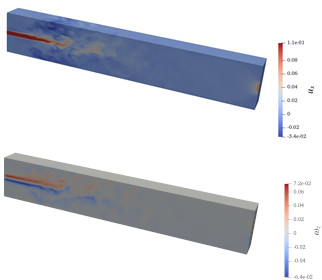Developing a multiscale continuum framework for exascale computing of fluids with microstructure
ARCHER2-eCSE09-10
PI: Dr Jianping Meng (University of Liverpool)
Co-I(s): Dr Charles Moulinec (STFC Daresbury Laboratory)
Technical staff: Dr Chrysovalantis Tsinginos (STFC Daresbury Laboratory)
Subject Area:

Flow of a micropolar fluid in a channel with 5 circular inlets in the left-hand side wall, arranged in the form of the 5 face of a dice – with the centred one slightly larger and a circular outlet located at the centre of the right-hand side wall, slightly bigger than the inlets. The left and right figure shows cross sections of the horizontal velocity, ux, and rotational velocity fields, ωz, fields, respectively.
Many natural and industrial processes involve fluids with a microstructure, e.g., landslides, avalanches, blood flows with clots, granular flows for chemical processes, and turbulence modelling. To model such fluids accurately, the evolution of the microstructure must be considered. Classical continuum theories are unable to correctly predict the evolution of the fluid microstructure. In contrast, atom-based methods can predict the evolution of the fluid microstructure with sufficient accuracy, but the enormous number of atoms, typically in the order of thousands of trillions, renders those methods prohibitive for the simulation of industrial-scale problems, even on current supercomputers. Continuum theories that introduce additional degrees of freedom to model the evolution of the fluid microstructure can bridge the gap between the computational accuracy of atom-based methods and the computational efficiency of continuum methods.
In this project, a new module entitled CS-MICRO was developed to extend the modelling capabilities of Code_Saturne, an open-source finite-volume scheme CFD code, to fluids with a micro-structure. A new pressure-implicit split operator type scheme for solving the transport equations of incompressible and compressible micropolar fluids has been developed. In addition, a volume of fluid method has become available for modelling incompressible micropolar fluids with free surfaces. Several simulations were carried out to benchmark the developed module. Strong scaling tests performed on ARCHER2 including meshes of 700 million cells indicate that the developed module retains the excellent parallel performance of Code_Saturne.
Information about the code
CS-MICRO will be accessible to all ARCHER2 users through its GitHub project along with an installation guide, tutorial case and support documentation. Currently, CS-MICRO is available to the ARCHER2 community from /work/c01/c01/shared/cs-micro.tar.gz
